The common ostrich (Struthio camelus) is the world’s largest living bird and a flagship species of Africa’s savannas, semi-arid plains, and desert margins. Though flightless, it is superbly adapted for terrestrial life, capable of reaching remarkable running speeds and surviving harsh, dry conditions with limited water. As one of only two surviving species in the genus Struthio, the common ostrich stands out for its distinctive evolutionary history, specialized physiology, and complex behaviors.
Historically found across parts of Asia and North Africa, the species has seen significant range contraction, with the Arabian subspecies now extinct. Today, the common ostrich persists mainly in sub-Saharan Africa, where it remains common in many protected areas and pastoral landscapes. Its ecological resilience, symbolic significance across cultures, and continued economic value – through farming, tourism, and sustainable use – ensure that this ancient bird remains a focus of both conservation and human fascination.
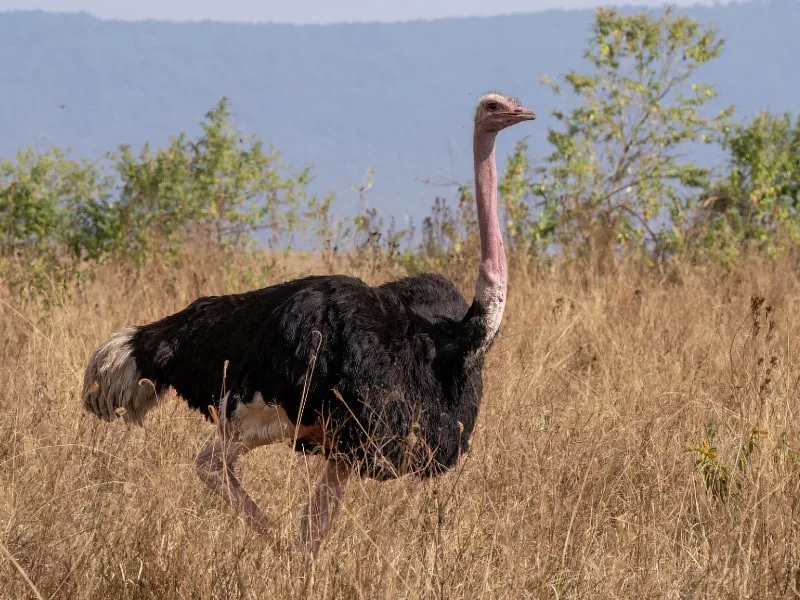
| Common name | Common ostrich |
| Scientific name | Struthio camelus |
| Alternative names | Ostrich, North African ostrich, red-necked ostrich (nominate subspecies); also known by subspecies names such as South African ostrich, Masai ostrich, etc. |
| Order | Struthioniformes |
| Family | Struthionidae |
| Genus | Struthio |
| Discovery | Described by C. Linnaeus in 1758 |
| Identification | Large flightless bird with powerful legs, long neck, and reduced plumage on head and thighs; males black-and-white, females brownish-grey; two toes per foot |
| Range | Now found across sub-Saharan Africa; formerly ranged into North Africa and the Middle East; introduced/farmed populations exist in Australia |
| Migration | Non-migratory; local movements occur in response to rainfall and resource availability |
| Habitat | Savannas, semi-arid plains, open woodlands, and desert margins; avoids densely forested areas |
| Behavior | Highly vigilant and territorial; fast runner; displays include booming, hissing, and elaborate courtship; aggressive when defending young |
| Lifespan | Typically 30-40 years in the wild; known to exceed 60 years in captivity |
| Diet | Primarily herbivorous: seeds, leaves, fruits, flowers; supplements with insects and small vertebrates; swallows pebbles to aid digestion |
| Conservation status | Least Concern (IUCN); North African population protected under CITES Appendix I |
Discovery
The common ostrich was formally described in 1758 by Swedish naturalist Carl Linnaeus in the 10th edition of his Systema Naturae. He assigned it the binomial name Struthio camelus, which remains in use today.
The genus name Struthio is derived from Late Latin for “ostrich,” while the specific epithet camelus references the Ancient Greek term strouthokamelos, meaning “camel-sparrow” – a nod to the bird’s arid habitat and long-legged, camel-like appearance. Variants of this name are still used in modern Greek and other languages, suggesting a long history of human recognition and description prior to formal scientific classification.
As a member of the infraclass Palaeognathae, the common ostrich belongs to a group of flightless birds known as ratites, which includes rheas, emus, cassowaries, and the extinct moas and elephant birds. It is one of only two extant species within the genus Struthio, the other being the Somali ostrich (Struthio molybdophanes), which was previously considered a subspecies (S. c. molybdophanes) but is now widely treated as a distinct species by BirdLife International, the IOC World Bird List, and The Clements Checklist.
The split is supported by mitochondrial DNA evidence, suggesting a divergence approximately four million years ago, likely associated with ecological separation following the formation of the East African Rift.
Within S. camelus, multiple subspecies have been described, most of which remain valid. These include the North African ostrich (S. c. camelus), South African ostrich (S. c. australis), and Masai ostrich (S. c. massaicus). Another form, the Arabian ostrich (S. c. syriacus), also known as the Syrian or Middle Eastern ostrich, was historically widespread across the Arabian Peninsula, the Levant, and parts of Mesopotamia, including present-day Iran, Iraq, Israel, Jordan, Kuwait, Oman, Qatar, Saudi Arabia, Syria, the United Arab Emirates, and Yemen. It became extinct around 1966 due to overhunting and habitat degradation.
An additional population from the former Spanish Sahara, originally described as S. c. spatzi based on differences in eggshell pore structure, was later synonymized due to overlapping traits. However, skeletal analyses published in the 21st century have revived some debate over its distinctiveness. Other putative forms, such as Levaillant’s ostrich (Struthio bidactylus), reported in the 19th century as small-bodied North African birds, remain hypothetical and lack physical evidence.
Taxonomically, the ostrich was once grouped in a broad order (Struthioniformes) that included all ratites. However, recent molecular studies have revealed that this arrangement was paraphyletic. Today, ostriches are classified as the sole extant members of Struthioniformes, which is now restricted to the genus Struthio. Phylogenetic studies position them as the sister group to all other Palaeognathae, reinforcing their status as an early divergent lineage within the avian evolutionary tree.
Identification
The common ostrich is the tallest and heaviest living bird. Adult males typically stand between 2.1 and 2.75 meters (6.9-9 feet) tall and weigh 100 to 130 kilograms (220-287 pounds), while females are slightly smaller, standing 1.75 to 1.9 meters (5.7-6.2 feet) in height and weighing 90 to 120 kilograms (198-265 pounds).
Exceptional individuals, especially among North African populations, have been recorded at up to 2.8 meters (9.2 feet) in height and 156.8 kilograms (345.7 pounds) in weight, making them the most massive known birds in modern times. In contrast, some individuals in southern populations may weigh as little as 59.5 kilograms (131 pounds).
The wings, though functionally flightless, span approximately 2 meters (6.6 feet) and play critical roles in display, balance, thermoregulation, and maneuverability during high-speed running.
Sexual dimorphism is pronounced in plumage coloration and skin pigmentation. Adult males display mostly black feathers with striking white primary and tail feathers, although tail color can vary slightly depending on subspecies. Females and immature males have a grayish-brown plumage that provides better camouflage in open habitats.

The neck and thighs of both sexes are sparsely feathered and exhibit subspecies-specific skin coloration, ranging from pink to gray. During the breeding season, males of some subspecies develop intensified coloration in the bare skin areas, often turning bright pink or red.
Juvenile ostriches hatch covered in pale fawn down with dark speckling. By 3 months of age, they begin developing a juvenile feather coat, and by 1 year, they have typically reached adult height. However, full adult mass is usually not attained until 18 months of age. Plumage becomes sexually differentiated during the second year, although coloration may remain duller than in fully mature adults.
Subspecies of S. camelus differ subtly in morphology, coloration, and geographic range. The nominate form, the North African ostrich (S. c. camelus), is the largest and displays a pinkish-red neck and upper legs. The South African ostrich (S. c. australis), generally darker in plumage, exhibits gray skin tones and is extensively farmed in southern Africa. The Masai ostrich (S. c. massaicus) is notable for its vivid pink neck and thighs during the mating season.
Ostriches possess distinct physical adaptations beyond plumage. Each foot has only two toes, with the larger inner toe bearing a thick, hoof-like nail that aids in stability and speed. The smaller outer toe lacks a nail entirely. Another striking feature is their prominent, dark eyelashes – modified feathers that help shield their exceptionally large eyes from dust and intense sunlight on open plains.
Vocalization
Despite being part of a primarily silent group of birds, the common ostrich possesses a surprisingly diverse vocal repertoire. Vocalizations are produced using a tracheobronchial syrinx – an organ with paired medial and lateral tympaniform membranes but lacking both a pessulus and a bulla, features commonly present in many other birds.
Anatomical studies have shown that the syrinx is structurally similar in both sexes and consistent across ontogeny, with only minor differences in cartilage geometry and labial thickness during development.
The most distinctive call is the closed-mouth boom, produced exclusively by adult males. This deep, resonant vocalization is generated by inflating a specialized sac in the throat and can carry over several kilometers. It plays a key role in territorial displays and mate attraction during the breeding season. The sound has been likened to a muffled lion’s roar or distant thunder and is typically delivered at dusk or during still conditions to maximize acoustic range.
Listen to the ostrich boom call:
In addition to the boom, ostriches produce hisses, growls, and honks. Hissing is a common defensive behavior in both sexes and is often accompanied by a forward posture and open wings. Growls and low moans may occur during close-range aggressive encounters or courtship. Chirps and peeping calls are frequently heard from chicks and juveniles, serving as contact calls within family groups.
Recent acoustic studies have also identified previously undocumented vocalizations, including simultaneous tonal and hissing elements. These findings expand our understanding of ostrich communication, which also includes non-vocal signals such as bill-snapping, feather rustling, and body posturing. Whistles and snorts have also been reported anecdotally, especially in close-range interactions or as startle responses.
Range
The common ostrich is native to much of sub-Saharan Africa and historically extended into the Middle East. Today, its distribution spans across large parts of the Sahel, East Africa, and southern Africa. The species occurs in Mauritania, Mali, Niger, Chad, Sudan, Ethiopia, Eritrea, Kenya, Uganda, Tanzania, Angola, Namibia, Botswana, Zambia, Zimbabwe, Mozambique, and South Africa.
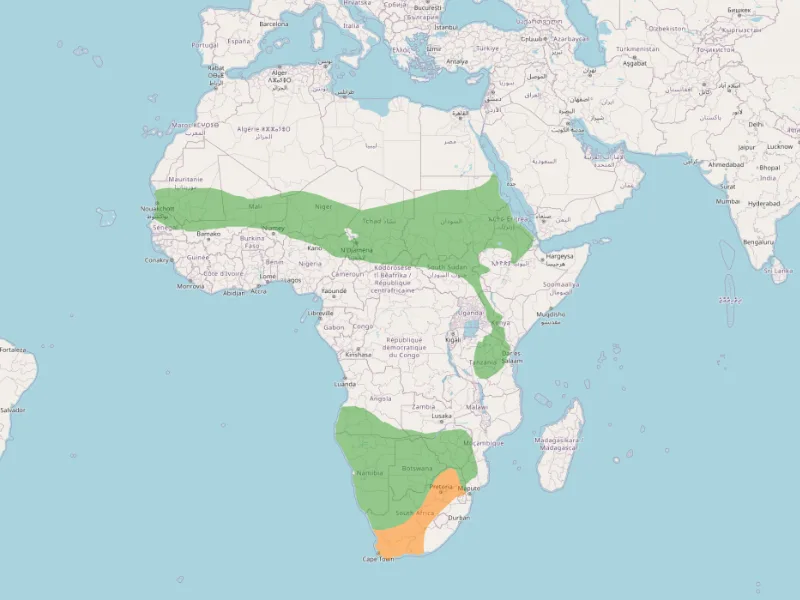
Historically, ostriches ranged north and south of the Sahara and into Asia Minor, but their presence in the Middle East has been eradicated. The Arabian ostrich (S. c. syriacus), once widespread across the Arabian Peninsula and neighboring regions, was declared extinct around 1966. Attempts at reintroduction in Israel have not succeeded. Feral populations have also become established outside the native range, most notably in parts of the Australian outback, following the escape of farmed individuals.
Each extant subspecies occupies a distinct region:
- The North African ostrich (S. c. camelus) is now restricted to fragmented populations in the Sahel region and is absent from much of its historical range.
- The South African ostrich (S. c. australis) is found across southern Africa, particularly in Namibia, Botswana, Zimbabwe, and South Africa.
- The Masai ostrich (S. c. massaicus) inhabits eastern Africa, with its core range in Kenya and Tanzania and smaller populations in Ethiopia, Somalia, and Uganda.
Isolated records also suggest occasional presence on islands such as those of the Dahlak Archipelago near Eritrea. Fossil DNA evidence from Late Pleistocene eggshells in India shows that ostrich-like birds closely related to S. c. camelus once inhabited the Indian subcontinent, though these populations are now extinct.
Migration
The common ostrich is a non-migratory species. Individuals and flocks remain within relatively fixed home ranges throughout the year. However, ostriches may undertake local movements in response to seasonal rainfall and food availability, particularly in arid and semi-arid zones.
These shifts are typically opportunistic rather than patterned or long-distance migrations and are more pronounced in open or desert environments where water and forage are patchily distributed.
Habitat
Ostriches are adapted to a variety of open and semi-open habitats, including savannas, dry grasslands, shrublands, and semi-desert regions. They avoid densely forested or mountainous terrain and are absent from rainforest belts.
In East Africa and the Sahel, they thrive in dry savanna ecosystems where visibility is high and escape from predators is aided by their speed. In the arid southwest of the continent, they can be found in true deserts, demonstrating exceptional tolerance for temperature extremes and water scarcity.
Although naturally occurring across diverse African landscapes, ostriches have also been widely domesticated and farmed, with managed populations present on multiple continents. Escaped farm birds have formed feral populations in parts of Australia, where they inhabit similar dry, open country to that of their native range.
Physiological adaptations
The common ostrich exhibits a suite of physiological traits that enable it to thrive in hot, arid environments and meet the demands of its large body size and active lifestyle. These adaptations span respiration, thermoregulation, osmoregulation, circulation, and metabolism, reflecting the evolutionary pressures of the open African savannas and deserts it inhabits.
Respiratory efficiency
Ostriches possess a complex avian respiratory system, featuring rigid lungs and 10 air sacs that enable unidirectional airflow across the gas exchange surfaces. This highly efficient arrangement allows for a large tidal volume (up to 1.5 liters) and a total respiratory capacity of approximately 15 liters in a 100-kilogram individual. Air is drawn into the lungs via a long, vascular trachea and passes through a paleopulmonic parabronchial system – a structure retained from early ratite ancestors.
Unlike many birds, ostriches can pant and perform gular fluttering to increase evaporative cooling without disrupting gas exchange, allowing them to regulate body temperature under extreme heat stress. Their respiratory anatomy also helps prevent alkalosis during heavy panting, a notable exception among birds.
Circulatory specializations
The ostrich heart supports a dual circulatory system with adaptations for high endurance and pressure regulation. The left ventricle is especially muscular, allowing for strong systemic circulation, while specialized Purkinje fibers and muscular moderator bands enhance the coordination and strength of contractions. Unique structural features in the atrioventricular valves and septa further support this efficiency.
Despite having a lower red blood cell count than mammals, ostriches compensate with unusually large erythrocytes and hemoglobin variants (types A and D) that facilitate oxygen delivery. Embryonic stages express hemoglobin E for high-affinity oxygen transport, which later shifts to adult forms optimized for heat and exertion.
Osmoregulation and water conservation
Ostriches are remarkably efficient at conserving water. They produce highly concentrated urine and can separate fecal and urinary waste within the cloaca. During dehydration, they reduce glomerular filtration rates and excrete minimal, viscous urine while reabsorbing water in the colon. The rectum and paired caeca function as microbial fermentation chambers and sites of water reclamation.
Unlike many birds, ostriches do not rely on nasal salt glands for osmoregulation, depending instead on renal and intestinal mechanisms. They also obtain significant water from succulent plants, and under certain conditions, food-derived moisture exceeds that from drinking.
Thermoregulation
Maintaining thermal balance is critical for a large-bodied bird in open landscapes. Ostriches regulate body temperature through evaporative cooling, vascular control, and behavioral strategies. They fluff or flatten their feathers to manage heat loss, expose unfeathered skin in hot conditions, and seek shade during peak temperatures.
Countercurrent heat exchange in the limbs and selective brain cooling via the ophthalmic rete help protect vital organs from thermal stress. In cold conditions, they conserve heat through piloerection, shivering, and vascular constriction in peripheral tissues. Their ability to tolerate mild hyperthermia enables them to reduce evaporative water loss while maintaining internal homeostasis.
Metabolic rate
Despite their size, common ostriches have a relatively low basal metabolic rate (BMR) compared to other non-passerine birds, a trait consistent with energy conservation in xeric environments. However, they exhibit a high metabolic scope during activity, with oxygen demands rising dramatically during running or thermoregulation. Their daily energy turnover is substantial, particularly when water and food are abundant.
Behavior
The common ostrich is a highly adapted cursorial bird, exhibiting a behavioral repertoire well suited to the open, predator-rich environments of Africa. Naturally diurnal, ostriches are most active during the early morning and late afternoon but may also forage under moonlight.
Outside the breeding season, they are typically solitary or form loose pairs, with group sizes of more than two birds accounting for only a minority of sightings. However, during the breeding period and in times of extreme aridity, they may form larger nomadic groups ranging from 5 to over 100 individuals.
These aggregations are sometimes seen moving alongside other large herbivores such as zebras and antelopes, facilitating mutual vigilance and predator detection.
Locomotion and vigilance
Locomotion is central to the ostrich’s daily activity and survival strategy. Even in captive settings, walking dominates time budgets and is frequently observed as a transitional behavior linking other actions.
Ostriches are the fastest-running birds in the world, capable of sustained speeds of over 70 km/h (43 mph) and bursts approaching 97 km/h (60 mph). Their stride, extending up to 5 meters (16.4 feet), is powered by long, muscular legs adapted for speed, endurance, and maneuverability.

While generally shy, ostriches rely on their keen eyesight and hearing to detect predators early, often fleeing long before a threat is near. When hiding, they may lay their neck and head flat against the ground to reduce visibility, sometimes creating the illusion that their heads are buried – an image that likely contributed to the persistent but false “head in the sand” myth.
Interspecies interactions
When escape is not possible, ostriches are capable of intense physical defense. Their forward-directed kicks are powered by muscular legs and clawed toes, including a prominent, blade-like nail on the larger toe. A defensive strike can exert up to 225 kilogram-force (2,210 N), sufficient to fatally wound a predator or human.
While typically used as a last resort, these kicks are formidable, and ostriches have been documented killing hyenas, lions, and people in defense of themselves or their young. In captive or farm environments, particularly during breeding season, these birds may become highly territorial and unpredictable.
Common ostriches frequently interact with other species in their habitat. They are known to associate with grazers such as wildebeest and zebras, capitalizing on shared alertness to predators. While adult ostriches are rarely preyed upon due to their size, speed, and vigilance, juveniles and eggs are vulnerable to a wide range of predators, including jackals, raptors, mongoose, and even Egyptian vultures, which have been observed using stones to break open ostrich eggs.
Human interaction and aggressive behavior
While common ostriches generally avoid confrontation with humans in the wild, they retain a strong instinct for territorial defense and may exhibit aggressive behavior when provoked or threatened. In both natural and captive settings, adult males are particularly reactive during the breeding season. Agonistic displays, such as hissing, kantling (a posture involving raised wings and lowered head), and rapid pacing, are used to deter intruders and assert dominance. Sudden movements, perceived threats, or unfamiliar visitors may elicit defensive responses, including forward kicks or charges.
Ostriches are capable of inflicting severe injuries with their powerful legs and clawed toes. Documented cases include deep lacerations, internal trauma, and even fatalities caused by defensive strikes. These risks are especially pronounced in areas where captive birds are housed near human activity, such as farms or zoological facilities. In regions like Oudtshoorn, South Africa, where wild and domestic ostrich populations overlap, 2-3 serious or fatal attacks occur annually, making the species one of the most dangerous birds in captivity.
Observational studies from zoological settings have shown that even in controlled environments with proper care, ostriches may display stress-related aggression. Males are especially prone to defensive hissing or pacing behaviors when exposed to unfamiliar humans. Nonetheless, ostriches bred in captivity typically exhibit a similar behavioral repertoire to their wild counterparts, with locomotion, thermoregulation, and dominance behaviors continuing to dominate activity patterns. Captive environments, when properly managed, can support welfare and longevity while also contributing to ex-situ conservation through breeding and population maintenance.
Breeding
The common ostrich follows a polygynous mating system with a distinctive social and reproductive structure. Sexual maturity is reached between 2 and 4 years of age, with females generally maturing six months earlier than males.
The breeding season varies by region but typically spans from March to September in many populations, though in some parts of southern Africa, wild ostriches lay primarily between July and January. Domesticated birds may breed for longer periods, often extending into late February.
Territorial males defend large areas, ranging from 2 to 20 square kilometers (0.8-7.7 square miles), and form harems of two to seven females. Of these, one is designated as the major female, forming a temporary pair bond with the male and taking on the primary maternal role in reproduction.
Courtship and mating behavior
Males initiate courtship with ritualized displays that include deep booming vocalizations, alternate wing flapping, and rhythmic ground pecking. Once a receptive female is attracted, the pair engages in a coordinated courtship routine: the male clears a symbolic nest scrape, while the female circles with wings lowered.
The male then performs a spiral head movement before mounting the female. This ritualized behavior ensures synchronization before copulation. In captive settings, ostriches may redirect these behaviors toward humans, reflecting strong imprinting tendencies in hand-raised individuals.
Nesting and egg laying
Nests are shallow scrapes in the ground, typically 30-60 centimeters (11.8-23.6 inches) deep and up to 3 meters (9.8 feet) wide, prepared by the territorial male. A communal clutch is laid by multiple females, usually up to three per nest in the wild, with each contributing several eggs.
The dominant, or major, female lays first and later discards excess eggs from subordinate females, typically reducing the final clutch to around 20 eggs. However, clutch sizes may be smaller in natural conditions, with 12-13 eggs per nest being common. Females are able to distinguish their own eggs within a communal clutch.
Ostrich eggs are the largest of any living bird species, measuring on average 15 centimeters (5.9 inches) in length, 13 centimeters (5.1 inches) in width, and weighing approximately 1.4 kilograms (3.1 pounds).
Incubation and hatching
Incubation is shared between the sexes in a coordinated manner that enhances camouflage. Females incubate during the day, when their brownish plumage blends with the surrounding soil, while males take over at night, their black feathers rendering them nearly invisible in darkness.

The incubation period lasts between 35 and 45 days – relatively short for a ratite, which may be an adaptation to reduce the risk of predation. Egg-laying in domesticated birds typically occurs every second day, with up to 16 eggs laid in succession. Peaks in egg production are often synchronized and spaced approximately six weeks apart.
Parental care
After hatching, chicks are precocial and mobile, but still vulnerable. The male often takes the lead in defending and guiding the brood, although both parents may contribute to chick rearing. Males are known to display distraction behaviors to divert predators and may become highly aggressive in defense of the young.
Despite such efforts, chick mortality remains high in the wild, with predation accounting for most losses. In captivity, parental behavior remains broadly similar, though influenced by reduced predation pressure and artificial incubation practices.
Lifespan
Common ostriches are among the longest-lived bird species, with a typical life expectancy in the wild estimated at 30-40 years. Adult birds that survive the high-risk juvenile stage may live for several decades under natural conditions. In captivity, where threats such as predation and nutritional stress are minimized, ostriches have been recorded to reach exceptional ages. The oldest known captive individual lived to 62 years and 7 months.
Despite this longevity, survival to adulthood is rare. Fewer than 10% of nests successfully complete the 9-week laying and incubation period, and only around 15% of chicks that hatch survive to their first year. These low early-life survival rates sharply contrast with the extended potential lifespan of mature birds, underlining a life-history strategy marked by high juvenile mortality and strong selection for robust adult traits.
Mortality factors and early survival
Juvenile ostriches face numerous survival challenges both in the wild and in captivity. In the wild, predation, exposure, and starvation are the principal causes of death among chicks. Nest predation is frequent, and even under natural conditions that favor clutch success, only a fraction of hatchlings reach fledging age. Studies in Zimbabwe found that wild clutches are typically shared by three females and contain 12-13 eggs, but only a few chicks from each nest survive beyond a few weeks.
Captive settings present their own risks. A study from a French zoological reserve reported that 41% of all captive ostrich chick deaths were caused by yolk-sac infections, especially in hand-reared individuals. Additional causes included trauma from adult conspecifics, crushing by parents, digestive disorders, and deformities such as tibiotarsal rotation, which was responsible for over one-third of chick deaths in a large-scale Australian study. Fading chick syndrome, salmonellosis, and stress-related myopathies also contributed to mortality rates under farm conditions.
Infections of bacterial origin, particularly those caused by Escherichia coli, Clostridium perfringens, and Salmonella spp., have been identified as major contributors to enteritis, a syndrome with up to 30-40% mortality in chicks under three months of age. In some outbreaks, mortality has reached nearly 100%. Viral infections, including enteroviruses and reoviruses, were also found to co-occur with intestinal damage.
Improper feeding and poor digestive adaptation can lead to gizzard impaction, as seen in a Zambian outbreak where recently imported juveniles died following ingestion of indigestible feed materials. This condition is preventable through appropriate diet and early veterinary intervention.
Collectively, these studies emphasize the fragile nature of ostrich chick development and the critical role of early husbandry practices in improving survival rates in managed populations. While adult ostriches are highly resilient, their success as a species, whether in the wild or in captivity, depends largely on overcoming the many hazards of early life.
Diet
Common ostriches are primarily herbivorous, with a diet dominated by plant material such as seeds, grasses, shrubs, flowers, fruits, and leaves. They also occasionally consume insects like locusts, small reptiles, and carrion, especially when plant food is scarce.
Because they lack teeth, ostriches swallow pebbles to aid in grinding food in their gizzard; up to 45% of the gizzard content may consist of stones and sand. Food is swallowed into the gullet as a bolus, which can reach 210 milliliters (7.1 fluid ounces) in volume, then passes directly to the gizzard where mechanical breakdown occurs.
Ostriches can survive for several days without water by extracting moisture from food and relying on metabolic water, but they readily drink and even bathe when water is available. Notably, they can withstand a dehydration-induced body weight loss of up to 25%.
Foraging behavior and dietary shifts
Ostriches spend over half their daylight hours engaged in feeding and foraging, a behavior influenced by time of day and food availability. In the wild, they often forage in arid environments such as the Namib Desert, targeting a limited range of green plants including species like Monechma arenicola and Blepharis spp..
During farming conditions, ostriches show seasonal shifts in plant preference, with succulent grasses such as Cenchrus ciliaris and foliage from Acacia tortilis and Balanites aegyptiaca forming dietary staples. They are also known to ingest mineral salts and, occasionally, feces.
In captivity, they adapt to commercial feeds including wheat bran and prepared rations with high efficiency, and their metabolic profiles shift based on diet composition. Alfalfa hay, for instance, increases uric acid and certain electrolyte levels.
Ostriches raised in intensive farming systems exhibit strong feed conversion performance in early growth stages, but their energy storage shifts from protein to fat deposition as they mature. Their high efficiency in digesting fibrous plant material makes them better adapted than poultry to pasture-based diets, especially under low-resource conditions.
Culture
The common ostrich has been a part of human culture for tens of thousands of years, influencing traditions, art, and economies across Africa and the Middle East. Archaeological finds such as engraved ostrich eggshells from the Howiesons Poort period, dating back over 60,000 years at South Africa’s Diepkloof Rock Shelter, highlight their importance in early hunter-gatherer societies.
In the arid Kalahari, San people still use ostrich eggshells as portable water containers and craft them into beads. Ancient Egyptian culture also valued the ostrich: a statue depicts Queen Arsinoe II riding one, and ostrich feathers adorned royal regalia in various African and Mesopotamian civilizations.
In Eastern Orthodox Christianity, decorated ostrich eggs are hung from oil lamp chains inside churches. Originally practical, meant to deter rodents from accessing the oil, they later took on symbolic significance. According to tradition, the ostrich hatches its eggs by staring at them unblinking, which was likened to the intense focus a believer should maintain during prayer.
Despite the widespread myth, ostriches do not bury their heads in the sand. This misconception may have originated from misinterpretations of their natural behaviors, such as ingesting sand and pebbles to aid digestion, or lying low to avoid detection. Another likely source is the egg-laying and rotation process, which involves the bird lowering its head to manage eggs placed in shallow sand pits.
Historically, ostriches were exploited by the Roman Empire for venatio games and as a luxury food item. In the 19th century, demand for ostrich feathers in European fashion nearly led to their extinction in the wild. Feather farming began as a conservation alternative in South Africa, where ostriches have been raised since at least the early 1800s. Today, they are still farmed globally for feathers, meat, and leather – the latter considered among the toughest commercial leathers available.
Ostrich meat, low in fat and cholesterol, is prized as a healthy red meat alternative. It is dark red when raw and nutritionally rich in protein, calcium, and iron. Farms that specialize in ostrich production often incorporate agri-tourism, offering tours, merchandise, and, less commonly today, ostrich rides.
Racing ostriches is a cultural phenomenon in parts of Africa and the United States. In South Africa and tourist venues in the U.S., events have featured ostriches fitted with saddles and reins, though these races have declined due to growing ethical concerns. Most farms now impose strict weight limits, making rides suitable only for children or small adults. Events like Arizona’s Ostrich Festival and races in Iowa, Kentucky, and Louisiana reflect the bird’s enduring novelty and appeal in popular culture.
Although the common ostrich has played only a minor role in global mythology or organized religion, its eggs, feathers, and formidable appearance have ensured its presence in human life across time – first as a wild resource, and now as both a farmed commodity and a cultural icon.
Threats and conservation
The common ostrich is currently assessed as Least Concern by the IUCN. Despite a declining trend, its vast distribution range, estimated at over 9.8 million square kilometers (3.8 million square miles), and relatively high abundance across much of its habitat mean that it does not meet the thresholds for a more threatened category.
The global population has not been precisely quantified but is generally considered frequent to abundant in suitable areas. Subspecies-level variation exists, however; notably, the Arabian ostrich (S. c. syriacus) was declared extinct around 1966.
Historical and current threats
Once heavily exploited for the plume trade, the common ostrich has suffered a significant population decline over the past two centuries. Modern threats are less focused on direct hunting and more centered on habitat loss, human encroachment, and fragmentation of open savanna ecosystems. In North Africa, remaining populations are protected under CITES Appendix I, which bans commercial international trade and tightly controls non-commercial exchanges.
While ostriches are commonly farmed for feathers, meat, and leather, truly wild populations now persist primarily within protected areas or private reserves. Their status outside these managed zones is increasingly precarious, especially in regions experiencing agricultural expansion and infrastructure development.
Role of protected areas and management insights
A recent multi-year study in Tanzania’s Tarangire-Manyara ecosystem showed variable ostrich densities across different land-use types. Ostriches thrived in some national parks but declined in others, suggesting that formal protection alone does not guarantee conservation success. Interestingly, ostrich densities were relatively high in a pastoral area with moderate human presence but declined sharply in a game-controlled zone with extensive human impact.
This study found that ostrich densities were positively correlated with the presence of large ungulates, indicating their potential use as broad ecological indicators of savanna health. However, ostrich trends did not consistently match those of mammal populations over time, cautioning against using them as surrogate indicators for long-term mammal monitoring.
Similar species
As the world’s largest flightless bird, the common ostrich (Struthio camelus) is most similar to other members of the ratite group. Though separated by geography and evolutionary history, these birds share several ecological and anatomical traits adapted to a terrestrial lifestyle.
Somali ostrich (Struthio molybdophanes)
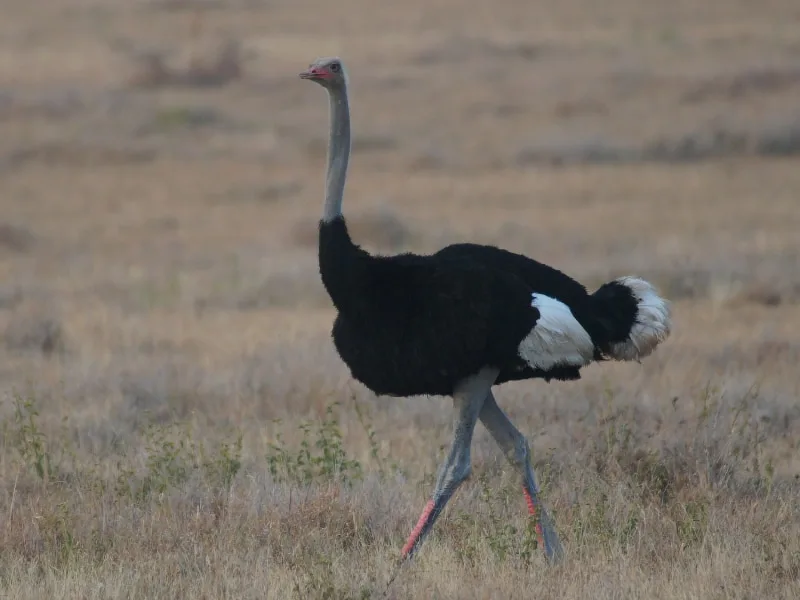
This species, once considered a subspecies of the common ostrich, is now recognized as distinct, primarily inhabiting the Horn of Africa. It has a blue-gray neck and thighs (brighter in males) and tends to occupy arid, bushier habitats than the nominate species. While similar in size and structure, the Somali ostrich is more solitary and less studied, with subtle differences in plumage and vocalizations.
Emu (Dromaius novaehollandiae)
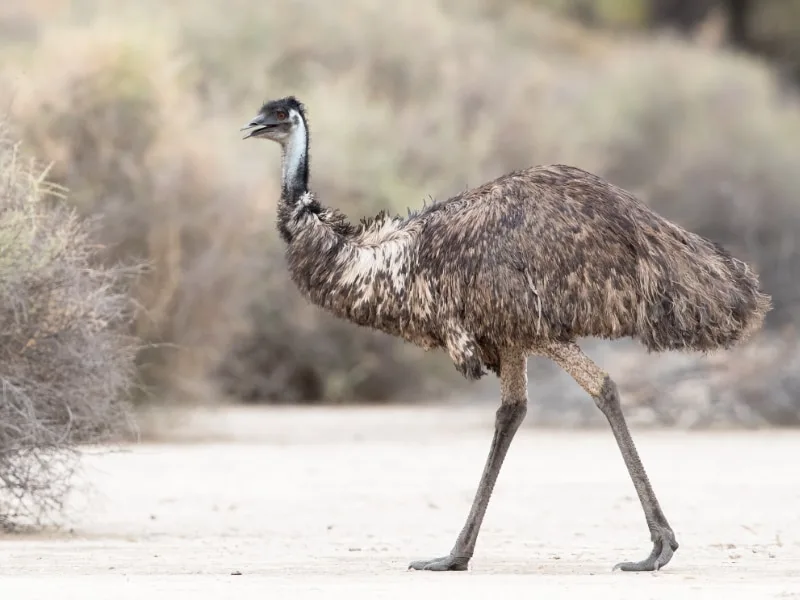
Native to Australia, the emu is the third-largest bird by height and bears a generally similar upright posture and long legs. Unlike the ostrich, emus have three toes instead of two, shaggy brown plumage rather than smooth black-and-white feathers, and a more uniform distribution across grasslands and forests. Emus are also less cursorial, relying more on browsing than sprinting.
Greater rhea (Rhea americana)
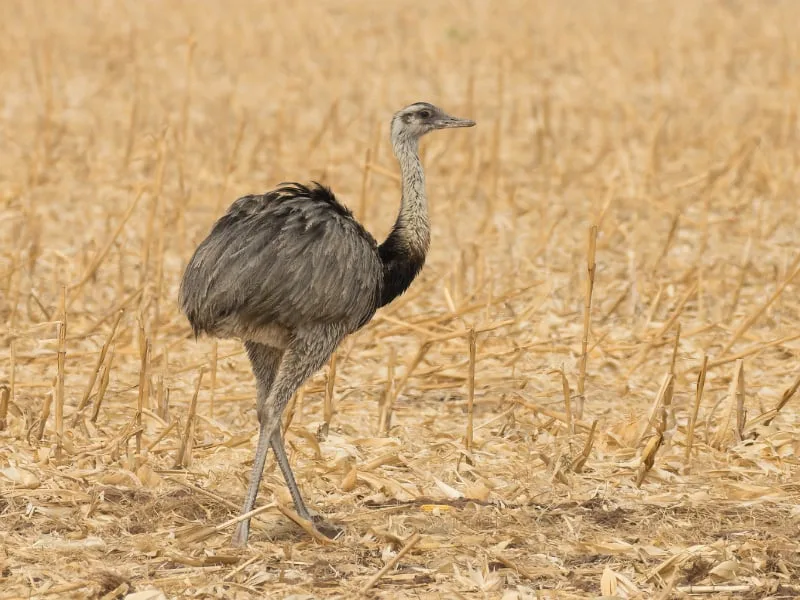
The largest bird in South America, the greater rhea is notably smaller than the ostrich but occupies similar open habitats such as pampas and savannas. Rheas have three toes and are more gregarious, forming larger flocks during certain seasons. Their grayish plumage and smaller body size make them more cryptic, and unlike ostriches, they lack the striking sexual dimorphism in plumage.
Southern cassowary (Casuarius casuarius)
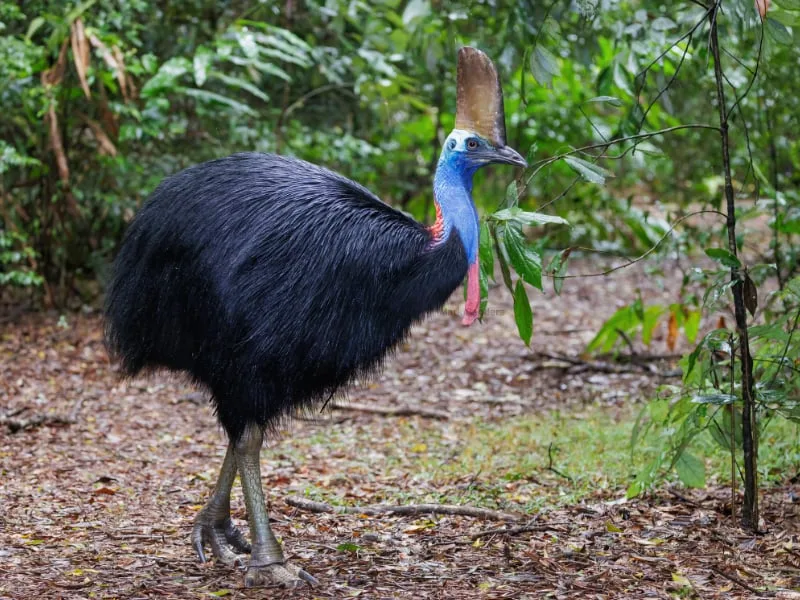
Although much shorter and stockier, the southern cassowary shares the ostrich’s flightlessness and powerful legs. It differs markedly in habitat preference, inhabiting dense tropical rainforests rather than open plains, and has a striking casque, bright skin coloration, and a reputation for aggressive defense. Its solitary, forest-dwelling behavior and fruit-heavy diet contrast sharply with the ostrich’s social, open-country lifestyle.
Future outlook
Despite historical declines and localized threats, the future of the common ostrich appears cautiously optimistic. The species remains widespread across sub-Saharan Africa and is classified as Least Concern by the IUCN. Successful farming practices have contributed to a more stable population globally, relieving pressure on wild birds. In some areas, ostriches have even become indicators of ecological health, highlighting their resilience in the face of human expansion and environmental change.
However, the continued survival of wild populations depends on the protection and management of suitable habitats. As arid and semi-arid ecosystems face increasing pressure from land degradation, agriculture, and climate change, ensuring long-term conservation will require region-specific strategies. Promoting coexistence with pastoralist communities, maintaining genetic diversity in farmed populations, and monitoring trends in wild ostriches will all be crucial. With coordinated efforts, the common ostrich can remain not just a cultural icon and economic resource, but also a thriving species in the wild.
Further reading
